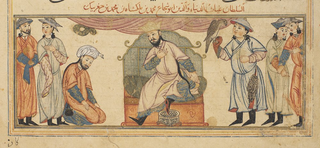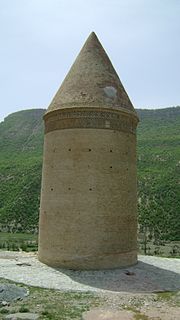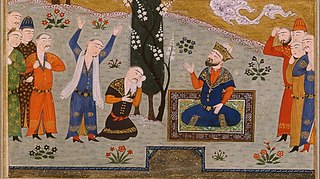Rustam III (Persian: رستم), was the ruler of the Bavand dynasty from 1117 to 1118. He was the son and successor of Qarin III.

Persian, also known by its endonym Farsi, is one of the Western Iranian languages within the Indo-Iranian branch of the Indo-European language family. It is primarily spoken in Iran, Afghanistan, and Tajikistan, Uzbekistan and some other regions which historically were Persianate societies and considered part of Greater Iran. It is written right to left in the Persian alphabet, a modified variant of the Arabic script, which itself evolved from the Aramaic alphabet.

The Bavand dynasty, or simply the Bavandids, was an Iranian dynasty that ruled in parts of Tabaristan (Mazandaran) in what is now northern Iran from 651 until 1349, alternating between outright independence and submission as vassals to more powerful regional rulers.
Qarin III, was the ruler of the Bavand dynasty from 1114 to 1117. He was the son and successor of Shahriyar IV.
Rustam III, shortly after his accession of the Bavandid throne, was challenged by his uncle Ali I, who claimed the Bavandid throne for himself. The Seljuq Sultan Muhammad I, then requested the two Bavandid rivals to appear in the Seljuq court of Isfahan. Rustam, however, refused, but later changed his mind and went to Isfahan, where he shortly fell ill and died. According to some sources, Rustam was poisoned by his stepmother, the sister of Muhammad I, who wanted to marry Ali I. Ali I then ascended the Bavandid throne.
Ali I, was the ruler of the Bavand dynasty from 1118 to 1142. He was the uncle and successor of Rustam III.

Isfahan is a city in Iran. It is located 406 kilometres south of Tehran, and is the capital of Isfahan Province.
This page is based on this
Wikipedia article Text is available under the
CC BY-SA 4.0 license; additional terms may apply.
Images, videos and audio are available under their respective licenses.

Muhammad I was a son of Seljuq Sultan Malik Shah I. In Turkish, Tapar means "he who obtains, finds".
Sayyida Shirin, also simply known as Sayyida, was a Bavandid princess, who was the wife of Buyid ruler of Ray, Fakhr al-Dawla. She was the de facto ruler of Ray during the reign of her son, Majd al-Dawla.

The Kakuyids were a Daylamite dynasty that held power in western Persia, Jibal and Persian Iraq. They later became atabegs (governors) of Yazd, Isfahan and Abarkuh from c. 1051 to 1141. They were related to the Buyids.

Muhammad ibn Rustam Dushmanziyar, also known by his laqab of Ala al-Dawla Muhammad, was a Daylamite military commander who founded in 1008 the short-lived but important independent Kakuyid dynasty in Jibal. He is also known as Pusar-i Kaku, Ibn Kakuyeh, Ibn Kakuya, and Ibn Kaku, which means maternal uncle in the Deylami language, and is related to the Persian word "kaka". Muhammad died in September 1041 after having carving out a powerful kingdom which included western Persia and Jibal. However, these gains were quickly lost under his successors.
Rustam I, was the ninth ruler of the Bavand dynasty from 867 to 896. He was the successor and son of Qarin I.
Sharwin II, was the tenth ruler of the Bavand dynasty from 896 to 930.
Ardashir II was the ruler of the Bavand dynasty from 1238 to 1249. His grandmother was a sister of Rustam V, and he was also related to the Nizari Ismaili Jalaluddin Hasan through his mother.
Rustam II, was the twelfth ruler of the Bavand dynasty from 964 to 979. He was the brother and successor of Shahriyar II.

Shahriyar IV, also known as Husam al-Dawla, was the king of the Bavand dynasty of Mazandaran, ruling from 1074 to 1114.
Bahram ibn Shahriyar, was an Iranian prince from the Bavand dynasty.
Al-Marzuban, was the thirteenth ruler of the Bavand dynasty from 979 to 986. He was the son and successor of Rustam II. In some sources, his name was changed to Rustam ibn al-Marzuban, which caused confusion among the historians, and made them think that they were two people.
Sharwin III, was the fourteenth ruler of the Bavand dynasty briefly in 986. He was the brother and successor of al-Marzuban.
Shahriyar III, was the sixteenth ruler of the Bavand dynasty from 986 to 987, and briefly in 998 after a short disruption during his reign. He was the nephew and successor of Sharwin III.

Abu Ja'far Muhammad, was the ruler of the Bavand dynasty from an unknown date until his capture and defeat by the Kakuyids in 1027.
Ardashir I, was the ruler of the Bavand dynasty from 1173 to 1205. He was the son and successor of Hasan I.
Rustam V, was the ruler of the Bavand dynasty from 1205 to 1210. He was the son and successor of Ardashir I.

Shah Ghazi Rustam, was king of the Bavand dynasty of Mazandaran, ruling from 1142 to 1165. He expanded the borders of the kingdom at the expense of his neighbors, particularly the Ismailis and the Seljuks. He established a Bavandid presence in Gilan as a result of his frequent vengeful raids against the Ismailis, who had assassinated his son and heir, Girdbazu. He also brought Qumis and Ray under Bavandid control during his wars against the Seljuks and the Karakhanids.











